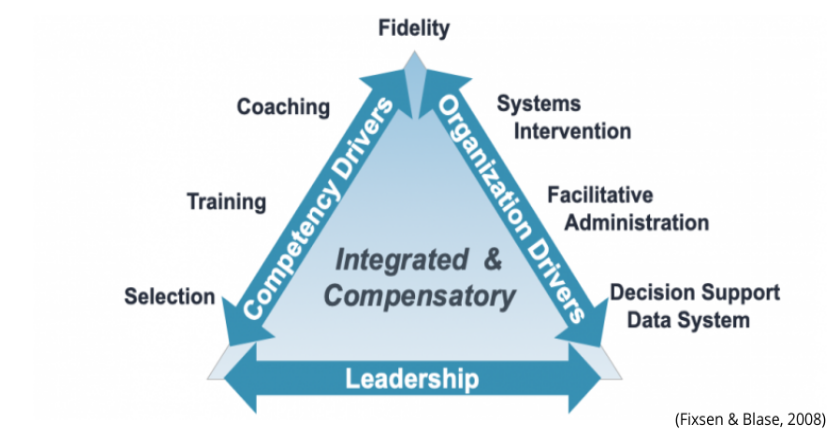Home > Implementation for Educators Blog
Leveraging Responsibilities to Strengthen Leadership

Introduction
Leaders are vital to successful implementation! They remove barriers and empower practitioners to create system-wide change. Leaders are typically driven, motivated, high-performing individuals who aim to reach their goals. High performers tend to take on more tasks than others because they believe in their abilities. Frequently, we discuss teacher burnout, but have we ever considered that leaders are burning out at an alarming rate as they are tasked with more responsibility than ever? (Rogers, 2025). The question is, how can we empower leaders without burning them out? Leaders must realize that they can’t control everything or be everything. Leaders must relinquish some power to improve their productivity and effectiveness.
“Implementation Drivers are the components of effective implementation needed to develop, improve, and sustain the ability of teachers and staff to implement a practice or program as intended, as well as create an Enabling Context for the new ways of work“ (NIRN, 2015, p. 3). The implementation drivers are composed of competency drivers and organizational drivers supported by leadership. The implementation drivers are an effective tool for leaders to delegate responsibilities while maintaining the ability to remove barriers and support implementation efforts. Distributed and shared leadership alleviates some stress while empowering others to become change agents. This blog aims to detail what distributed and shared leadership are, their similarities, and their differences.
What is Distributed Leadership and Shared Leadership?
Distributed leadership is the idea that the leadership of an organization is “distributed” across multiple people instead of just one leader doing all of the work (ECTA, 2025).
Shared leadership is the practice of governing an organization by expanding the number of people involved in making important decisions related to the school’s organization, operation, and academics (The Glossary of Education Reform, 2013).
Both types of leadership focus on improving decision-making processes, which lead to more responsive support to areas of need. Improved capacity is another benefit of both leadership styles, promoting continued learning and innovation. These types of leadership boost engagement and increase teamwork within the organization. This allows for shared responsibility throughout the system. These types of leadership also create improved communication structures where knowledge can be shared along with learning. This learning can lead to improved implementation efforts and outcomes being achieved. The most important benefit is that these types of leadership will improve performance and build a culture that values all critical perspectives, voices, thoughts, and opinions. Building a successful culture is very important because it builds community, continuity, and the belief that we are all on the same page with how business is done in an organization.
“Distributed leadership is first and foremost about leadership practice rather than leaders or their roles, functions, routines, and structures” (Spillane, 2005, p.144). Distributed leadership and the organizational drivers are similar and somewhat coordinated because leaders empower others to make decisions in their roles. If you consider a central office in a school district, the superintendent empowers directors and coordinators to make decisions aligned with the larger district’s goals.
Shared leadership is about providing opportunities and a voice to all. “Competency Drivers are the activities to develop, improve, and sustain educator and administrator ability to put programs and practices into practice, so students benefit” (NIRN, 2015, p. 5). Shared leadership coordinates with competency drivers. Competency drivers are composed of selection, coaching, and training. An example is school administrators empowering staff members to lead teams in schools that directly support desired outcomes. These teams are typically replicated in all buildings and have similar functions. Building administrators empower staff to take leadership roles within their schools. The team approach allows for the voices of all stakeholders to be heard. The competency drivers allow for the appropriate staff selection, training, and coaching supports that build capacity within the team and guide teams as they strive for effective implementation. School alignment is key; if all schools are aligned and working toward similar outcomes, those outcomes lift performance district-wide. This alignment leads to improved outcomes that raise the district’s overall performance and support the district in attaining desired goals.
Why are Distributed Leadership and Shared Leadership Important?
“The use of Leadership in the context of Active Implementation focuses on leadership approaches related to transforming systems and creating change” (NIRN, 2015).
The importance of leadership can not be overstated. Making decisions and removing barriers is a significant key to implementation efforts. Leaders must understand that they can’t do everything and be everything to everyone. To be the most effective version of themselves, there must be a willingness to distribute leadership and share leadership responsibilities to function at maximum capacity. As we consider the implementation drivers, we must consider technical and adaptive challenges. “Technical challenges are those characterized by pretty clear agreement on a definition of the dimensions of the problem at hand” (NIRN, 2015, p. 14). Distributed leadership addresses technical challenges because typical management approaches work to solve these challenges. Distributed leadership is a more traditional approach regarding a leader empowering and assigning leadership roles to others to complete required tasks. “Adaptive challenges involve legitimate, yet competing, perspectives – different views of the problem and different perspectives on what might constitute a viable solution” (NIRN, 2015, p. 15). Shared leadership incorporates many of the adaptive strategies to solve adaptive challenges. Valuing the voice of stakeholders and empowering others to take leadership roles allows for understanding and planning that considers all views to address challenges.

Leadership is essential to implementation and the foundation supporting the competency and organizational drivers. Leadership is key because it supports emerging challenges, and we can consider making those changes to improve outcomes. Leaders provide guidance, empower staff, and support decision-making vital to successful implementation efforts.
Case Examples
Shared Leadership in Action: How implementation Teams support Yonkers Public Schools District, Yonkers, NY
In Yonkers, we have developed implementation teams to support districtwide initiatives, as it is challenging to roll out essential initiatives with consistent messaging across 40 schools when these teams do not exist. Currently, we are engaged in two codependent initiatives supported by implementation teams. The first is our MTSS Committee, where a team created district-wide guidance that informs and dictates consistent procedures for school-based teams. These teams will use different data sets to make informed intervention decisions for students, including common assessment data. Common Assessments is the other initiative that has invited an implementation team to identify essential standards, develop common unit assessments across the district, and input these assessments into an assessment platform that supports reporting for teachers to take action in their classrooms and for the MTSS teams at each school to stay informed. By utilizing shared leadership, teams of professionals share the workload, making the district more efficient in addressing student needs. Paraphrasing the words of John C. Maxwell, great leaders never walk alone (Wall, 2015). Staff ultimately feel more inspired and empowered when an organization has shared leadership.
Distributed Leadership in Action: ECTA Center’s Story
When the Early Childhood Technical Assistance (ECTA) Center shifted to a distributed leadership model, we weren’t just tweaking an org chart—we were redistributing power, so decisions live where the expertise already resides. Instead of a single leader, a team of six co-leaders now guide the Center’s six core infrastructure areas (Strategic Planning and Budgeting; TA Deliverables and Activity Planning; Organizational Structure, Professional Development, and Teaming; Communications, Marketing, and Product Development; Outreach, Partnerships, and Collaboration; and Evaluation and Reporting). Leaders on the team arrange themselves in clusters of 2-3 people to co-lead infrastructure areas that best align with their strengths and lived experience. This has resulted in the team exploring different perspectives, accelerating decisions, and generating new ideas that a single leader could never surface alone.
As a result, ECTA is seeing faster, deeper collaboration. Center staff know they can connect to any leadership team member to request guidance or decisions for their work. That leader will loop in the appropriate co-lead to provide a quick response, which eliminates the need to wait in a queue for a single leader’s response. This creates clearer accountability loops, allowing co-leads for each core infrastructure to give “what we moved/what’s next” updates during leadership huddles. Hence, decisions stay transparent, and decision‑makers in each area can gather feedback and additional information from other leaders to adjust and correct course in real time, as needed.
The center now has a more comprehensive understanding and exchange of ideas. Distributing authority across infrastructure areas surfaces perspectives not in a traditional hierarchy, leading to more relevant and effective leadership decisions and high-quality TA support and products. The leadership team members’ diverse experiences and perspectives also bring insights to planning and decision-making that weren’t considered in the traditional hierarchical structure. Distributed leadership allows for greater agility and responsiveness. Distributed authority lets us pivot budgets, staff time, or TA focus within days–sometimes hours–when our clients’ and partners’ needs shift.
Closing
As you have read this blog, you have learned the definitions of distributed and shared leadership. As you consider the implementation driver, remember that competency and organizational drivers are supported by leadership. Distributed leadership has more of a focus on organizational drivers and ensuring that the leaders in those areas are responsible for making decisions within their departments that are aligned with the district’s goals. Shared leadership supports competency drivers by ensuring staff members’ selection, training, and coaching to be adequately prepared to make proactive decisions to support student outcomes. Leadership is integrated and compensatory as we consider the drivers and ensure alignment within the organization. The goal is not for leaders to be less involved but to empower others. Hopefully, it provides insight into how leaders can learn to provide opportunities to grow leaders within an organization. It also creates an infrastructure where leadership is distributed or shared throughout the organization to engage all critical perspectives to lead and make their voices heard while supporting implementation efforts.
Call to Action
If you are currently in a leadership role, take a moment and consider opportunities to share and distribute leadership within your organization that provide an opportunity for others to grow. If you aren’t currently in a leadership role, but are considering leadership opportunities in the future, seek out leadership opportunities. You can start as a team member and continue to grow your skills and earn more responsibility and opportunity as you demonstrate growth in your leadership skills. The Cultivating Leadership Interactive Lesson on the Active Implementation Hub is a resource you can visit to continue learning about leadership.
Resources
- Cultivating Leadership Interactive Lesson
- NIRN Implementation Drivers Overview
- Leading by Doing Blog
References
Early Childhood Technical Assistance Center. (2025). Distributed leadership at ECTA. University of North Carolina at Chapel Hill. Retrieved April 30, 2025, from https://ectacenter.org/about/distributed-leadership.asp
National Implementation Research Network. (2015). Implementation drivers overview. University of North Carolina at Chapel HIll. Retrieved April 30, 2025, from https://implementation.fpg.unc.edu/wp-content/uploads/Implementation-Drivers-Overview.pdf
Rogers, L., Nguyen, T., Timmer, M. & Samson, J. (January 13, 2025). Principal burnout: A systematic review [Working paper]. Available at SSRN: https://ssrn.com/abstract=5096001 or http://dx.doi.org/10.2139/ssrn.5096001
Spillane, J. P. (2005). Distributed leadership. The Educational Forum, 69(2), 143–150. https://doi.org/10.1080/00131720508984678
The Glossary of Education Reform. (2013). Shared leadership. Retrieved April 30, 2025, from https://www.edglossary.org/shared-leadership
Wall, D. (2016, August 25). John C. Maxwell: Great leaders never walk alone. Nordic Business Forum. https://www.nbforum.com/nbreport/john-c-maxwell-great-leaders-never-walk-alone/Zhu, J., Liao, Z., Yam, K., Johnson, R. (2018) Shared leadership: A state-of-the-art review and future research agenda. Journal of Organizational Behavior, 39(7), 834–852. https://doi.org/10.1002/job.2296

